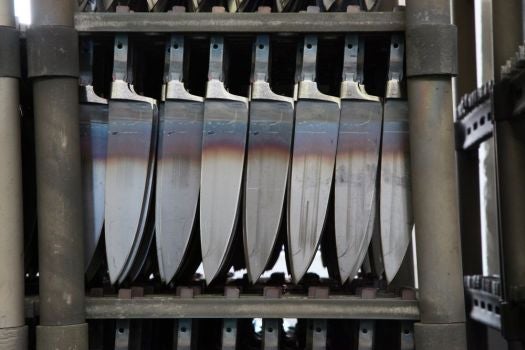Inside the Factory: How a Chef’s Knife Is Made
PopSci goes to Germany to witness the cutting edge of manufacturing

Last week, I visited Solingen, Germany’s “city of blades,” where knives, swords, and the like have been made for centuries. In between sipping beers and munching wursts, I paid a visit to the factory of Zwilling J.A. Henckels, at their kind invitation, to peer at the semi-roboticized lines where they produce their knives.
The raw material comes into the factory on huge spools of sheet steel, each sheet the thickness of a knife. The steel is cut into individual blanks, destined to become individual knives. About three weeks elapse between when a blank comes off the spool and when it emerges, a finished knife, at the other end.
In my breathless tour of the factory, I watched as a giant press cut and stacked the blanks, which are made of the company’s secret blend of stainless “special formula steel.” The blank is transported to another building, where the first of the factory’s 90-odd industrial robot arms takes it in hand.
In the classic design, the knife has a thickening where the blade meets the handle (aka the bolster). This is formed first, by heating the middle of the blank, and then pressing the metal’s two ends together so the molten middle bulges and widens, in a process that my contact specifies is called upset forging. Next, a drop forge shapes the bolster, before the blank is quickly cropped into the rough shape of the knife it’s going to be.
After that, it proceeds through a series of cooling, supercooling, and heat-tempering steps that give it its corrosion resistance and toughness. This is one of the benefits of the special steel, I’m told — it heats and cools in very predictable ways, allowing the factory to use more precise temperatures rather than temperature ranges.
After the tempering, any distortions or warpings that the heat has created in the blade are hammered out by a highly skilled human, who picks up and eyes each knife, one at a time, and flattens any that need flattening with precise strokes of a little hammer.
The knife passes into the hands of another series of robots, which use grinding wheels to narrow down the thickish blank into the tapered contour of a blade. Only roughly, though — the fine grinding and sharpening, as well as putting on the handles, is left to the factory’s humans, who wear puffy gray overalls and exude the confidence that comes with being extremely good at your job, and quite possibly coming from a line of knifemakers generations old. Wooden handles are glued onto the tang of the knife and then riveted in place; plastic handles are simply melted on by heating the tang and inserting it in a ready handle. The edges of the handles are smoothed by robots.
Finally the knife is cleaned and passes onward to the scrutiny of the quality assurance women. If it has no flaws — there’s a big photo-book of possible flaws — it gets packed up and winds up in someone’s kitchen.
Check out the step-by-step gallery of pictures from the knifemaking process.

Raw Material

Gallery: Inside a Knife Factory

Superheated

Remnant

Stages of Forging
Getting Closer
Cooling Tanks
Annealing Ovens
Outside the Factory

Grinding the Knife
The Process
Grinding Wheels
Serrated Grinding Wheels

The Knife Get Its Handle
Sharpening Is Done by Humans

Skilled Labor
Discarded Edging Belts
Precision
Polishing

Quality Assurance

Finished!